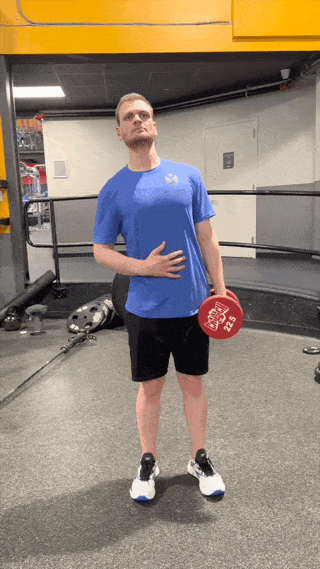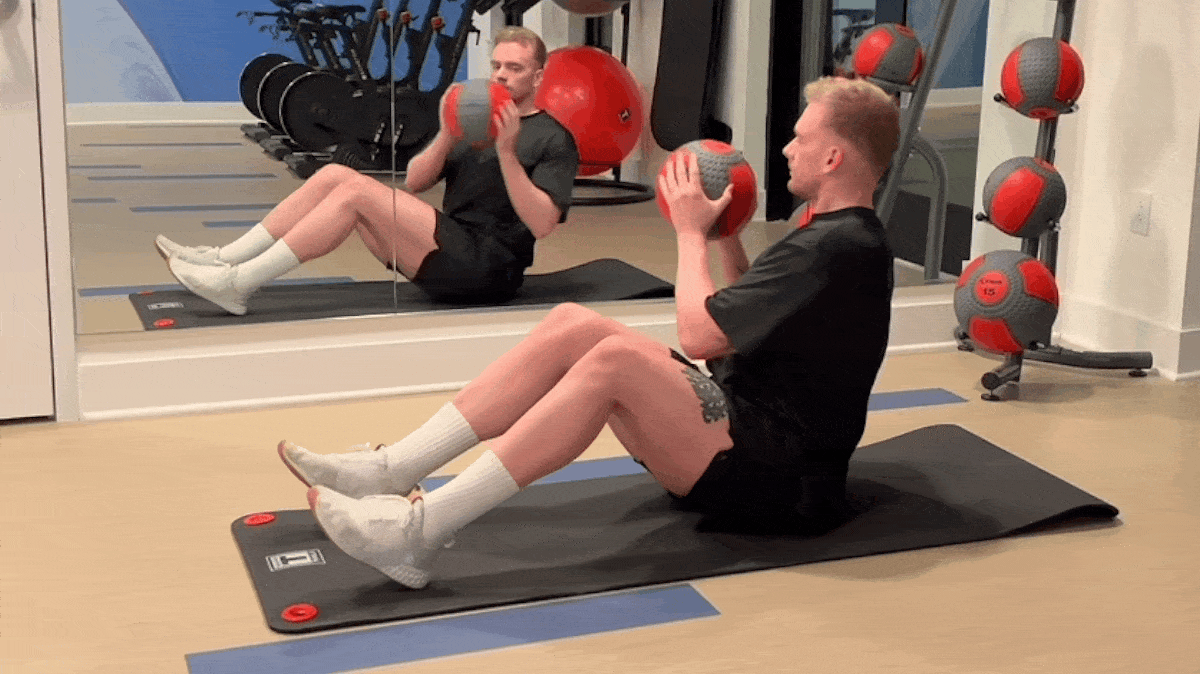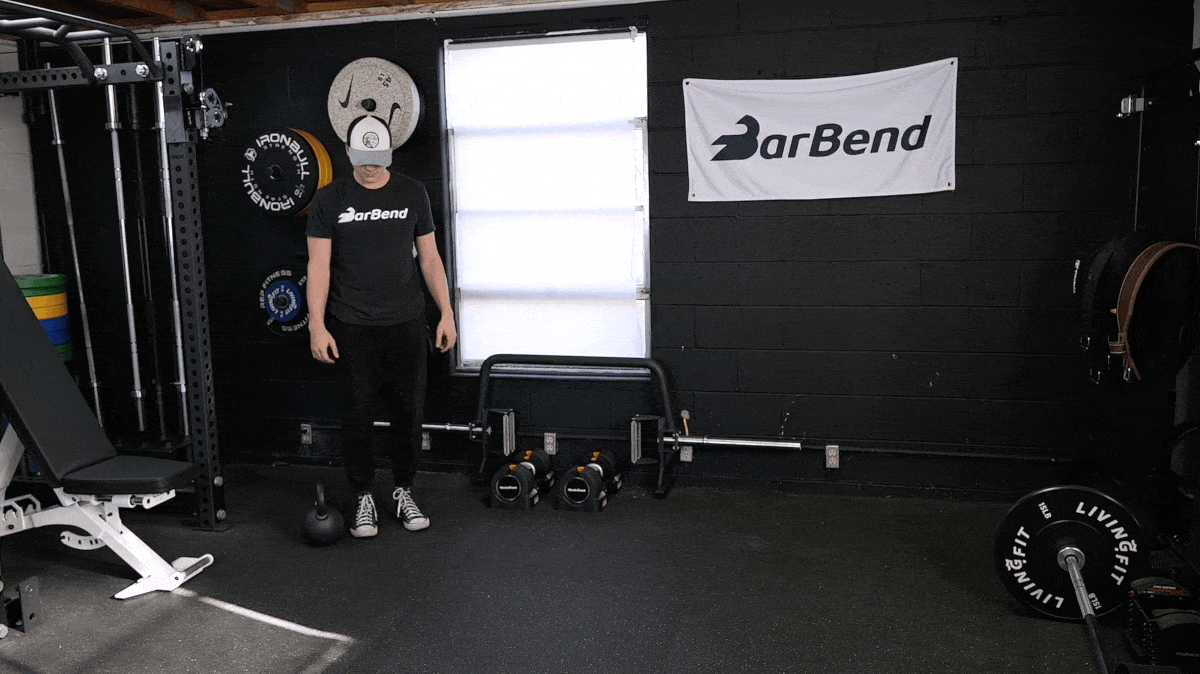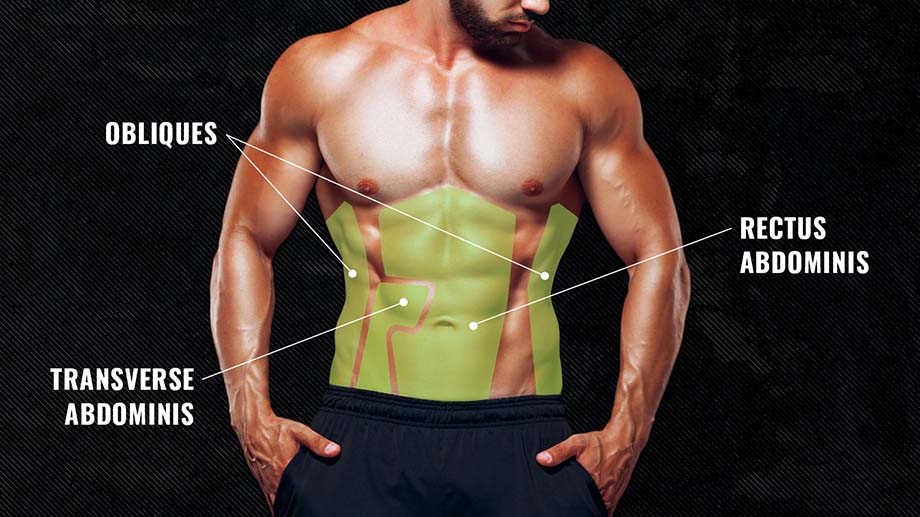We’ll spill the beans — at BarBend, we love dumbbell exercises. And core workouts. Put them together and we’re over the moon. If you feel the same, or you’re on the hunt for a new dumbbell ab workout yourself, you might want to try the dumbbell side bend. This ab and oblique core exercise is all you need to build up your torso strength and develop real-world stability in the process.
How To Do the Dumbbell Side Bend

As far as abdominal exercises with dumbbells go, the side bend is pretty simple. To do this move, you’ll need a single dumbbell, some space to work, and that’s about it.
- Step 1 — Stand upright with a roughly hip-width stance, holding a dumbbell at your side in one hand.
- Step 2 — Tip over toward the side you’re holding the weight with until you feel a significant stretch on the opposite side of your abdomen.
- Step 3 — Reverse the motion, using your core muscles to pull yourself upright.
Sets and Reps
- For Muscle Growth: 3 x 10-12
- For Strength: 3 x 6-8
Modifications
- Make It Easier: Place your non-working hand on your hip or hold it aloft out to the side to stabilize yourself and improve balance.
- Make It Harder: Try using a B-stance; stagger your feet, placing your non-working-side leg slightly behind your midline, and stand only on the ball of that foot.
Dumbbell Side Bend Variations
The dumbbell side bend isn’t the most customizable movement out there. However, you can perform a few side bend variations by changing the equipment you use.
[Read More: Exercises to Strengthen the Lower Back & Prevent Pain, Plus 3 Workouts]
- Cable Side Bend: By holding on to an adjustable cable handle set down by the floor, you can apply consistent mechanical tension to your core muscles. You can also stand on a box or lower riser to lengthen your range of motion even further.
- Kettlebell Side Bend: Kettlebell side bends are very similar to the dumbbell version, but you might find the handle of the kettlebell more comfortable to hold onto.
Dumbbell Side Bend Alternatives
Sick of side bends? We feel you — no core exercise is fun to do too often or for too long. If you’re looking for a dumbbell side bend alternative to spice things up, we recommend taking one of these for a spin:
Russian Twist

[Read More: The Best Online Workout Programs For Coaching, Cardio, Value, And More]
- Sit on the floor with your legs slightly bent and your heels gently touching the ground.
- Hold a medicine ball or small weight with both hands around chest level.
- With your torso at a 45-degree angle relative to the floor,
- Without moving your legs, slowly twist your torso from left to right, gently touching the object you’re holding to the floor.
Suitcase Carry

[Read More: The Best Budget Home Gym Equipment]
- Stand next to a heavy dumbbell or kettlebell.
- Hinge down, pick up the weight with one arm, and stand up straight.
- Align your ribcage and pelvis, brace your core, and take small steps forward. Avoid tilting your body toward the side of the weight you’re carrying.
Muscles Worked by the Dumbbell Side Bend

The dumbbell side bend is a one-stop shop for core training. The unique range of motion makes this move a stellar pick for targeting the various muscles in your core. Here’s a brief breakdown:
- Obliques: Your internal and external obliques sit on the sides of your lower abdomen. During the dumbbell side bend, these muscles stretch as you tilt your body from side to side and contract to help pull your body upright.
- Rectus Abdominis: Your primary abdominal muscle works in conjunction with the obliques to tilt and straighten your trunk, though the rectus abdominis is considered an accessory mover during this exercise.
- Forearms: Your forearm muscles must contract isometrically to firmly clasp the weight you’re holding and keep it in your hand for the duration of your set.
Benefits of the Dumbbell Side Bend
Dumbbell side bends are your one-stop shop for core training. They’re one of the few ab exercises with dumbbells you can do while standing up, and they train your body through a unique range of motion of tilting from side to side. But the benefits don’t end there.
Accessible Almost Anywhere
One of the best things about the side bend exercise is that you can do it basically anywhere — either at home if you have a dumbbell on-hand, or in a commercial gym with the weights available in the dumbbell rack. This makes it an easy exercise to stick with over time, since you can always grab a weight and get to work.
Easy To Perform
Some ab training workouts consist of exercises with complicated or inaccessible techniques. On the spectrum of “floor crunch” to “dragon flag” (yes, that’s a real one), dumbbell side bends fall firmly on the side of crunches. They’re straightforward, easy to learn, and isolate the muscle you’re trying to work.
Great For Supersets
One way to effectively train your core if you’re short on time is to perform supersets; pairing two movements together and doing them with no rest in-between. Supersets are great if the moves you pair up are practical and don’t require lots of setup or valuable equipment in a crowded gym.
[Read More: The Most Effective Workout Splits, Created by Our Experts]
Side bends shine here. All you need is a small open space and a single dumbbell and you’re off to the races. Superset side bends with suitcase carries, dumbbell-weighted dead bugs, or even a bodyweight ab exercise like the plank or side plank.
Common Dumbbell Side Bend Mistakes
Side bends with dumbbells may be simple, but you should still be aware of a few common errors that people typically commit while performing the exercise. Steer clear of these and you’ll be in great shape:
Rounding Your Back
The side bend exercise with a dumbbell (or any other weight) trains a motion called lateral flexion of the thoracic and cervical spine. In plain English, you’re training the muscles around your spinal column to bend your spine and then pull yourself upright again.
[Read More: The Best Back Exercises And Full Workouts To Build Muscle And Strength]
You’ll want to isolate this motion by preventing any forward rounding of your back. Shift only from one side to the other. It may help to imagine that you’re standing in a very narrow alleyway if you need a mental cue.
Holding Two Weights
You don’t want to hold two dumbbells at once during the side bend. Think of it this way; you’re offsetting the unilateral (single-sided) resistance with equal weight on the opposite side of your body. This makes it easier to balance and stabilize your spine, even though that’s the exact quality you’re trying to challenge while you perform side bends for your abs and obliques.
[Read More: The Best Adjustable Dumbbells for Your Home Gym]
The weight held on your non-working side also isn’t doing anything productive other than fatiguing your grip. This is a very common mistake for anyone who starts doing side bends during their ab workouts, so don’t feel bad if you’ve done it in the past.
Hip Shift
When performing side bends, your goal is to tilt your spine from side to side without moving your hips. Resist the temptation to slide your pelvis to the left or right as you do side bends. Doing so isn’t harmful or dangerous, but it interferes with your ability to isolate the muscles you’re trying to work.
Get Bendy
No matter your training goal, dumbbell side bends are a great option for building ab muscles and developing all-around core strength and stability. You can perform them just about anywhere with almost (you do need a dumbbell, of course) no equipment, and the technique is simple and easy to learn.
Frequently Asked Questions
Are dumbbell side bends effective?
It depends. An exercise’s usefulness depends on the goal you’re working towards. If you’re trying to stimulate your oblique and abdominal muscles, the dumbbell side bend is a fantastic option.
What muscles do side bends work?
Side bends, whether holding a dumbbell, kettlebell, or any other type of weight, will always target your obliques on the sides of your torso, as well as your rectus abdominis muscles around your stomach.
Do side bends get rid of love handles?
No. There’s no such thing as spot fat reduction, unfortunately. To get rid of love handles, you’ll need to spend time in a calorie deficit and lose body fat overall. That said, dumbbell side bends do burn a small number of calories, which will contribute to weight loss if you’re in a deficit.
Do dumbbell side bends make your waist smaller?
Not quite. Training a muscle with weights will generally create hypertrophy, enlarging the tissue. Growing your obliques by doing lots of side bends may actually make your waist appear larger or thicker from the front as those muscles grow.
The post Dumbbell Side Bend: How To + Core Workout Training Tips appeared first on BarBend.

